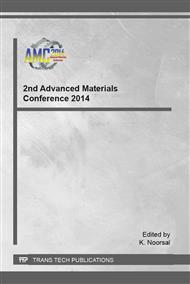[1]
K. Zhong, Z. -T. Lin, X. -L. Zheng, G. -B. Jiang, Y. -S. Fang, X. -Y. Mao, et al., Starch derivative-based superabsorbent with integration of water-retaining and controlled-release fertilizers, Carbohydrate Polymers, vol. 92, p.1367, (2013).
DOI: 10.1016/j.carbpol.2012.10.030
Google Scholar
[2]
S. Jin, Y. Wang, J. He, Y. Yang, X. Yu, and G. Yue, Preparation and properties of a degradable interpenetrating polymer networks based on starch with water retention, amelioration of soil, and slow release of nitrogen and phosphorus fertilizer, Journal of Applied Polymer Science, vol. 128, pp.407-415, (2013).
DOI: 10.1002/app.38162
Google Scholar
[3]
S. Baumberger, C. Lapierre, B. Monties, and G. D. Valle, Use of kraft lignin as filler for starch films, Polymer Degradation and Stability, vol. 59, pp.273-277, 1/3 (1998).
DOI: 10.1016/s0141-3910(97)00193-6
Google Scholar
[4]
M. M. Pang, M. Y. Pun, and Z. A. M. Ishak, Degradation studies during water absorption, aerobic biodegradation, and soil burial of biobased thermoplastic starch from agricultural waste/polypropylene blends, Journal of Applied Polymer Science, vol. 229, pp.3656-3664, (2013).
DOI: 10.1002/app.39123
Google Scholar
[5]
S. Lepifre, M. Froment, F. Cazaux, S. Houot, D. Lourdin, X. Coqueret, et al., Lignin incorporation combined with electron-beam irradiation improves the surface water resistance of starch films, Biomacromolecules, vol. 5, pp.1678-1686, 2004a.
DOI: 10.1021/bm040005e
Google Scholar
[6]
İ. Çalgeris, E. Çakmakçı, A. Ogan, M. V. Kahraman, and N. Kayaman-Apohan, Preparation and drug release properties of lignin-starch biodegradable films, Starch - Stärke, vol. 64, pp.399-407, (2012).
DOI: 10.1002/star.201100158
Google Scholar
[7]
O. Gordobil, I. Egüés, R. Llano-Ponte, and J. Labidi, Physicochemical properties of PLA lignin blends, Polymer Degradation and Stability, vol. 108, pp.330-338, (2014).
DOI: 10.1016/j.polymdegradstab.2014.01.002
Google Scholar
[8]
Z. Majeed, N. K. Ramli, N. Mansor, and Z. Man, Comprehensive Review on Biodegradable Polymers and Their blends Used in Control Release Fertilizers Processes, Reviews in Chemical Engineering, vol. 31, pp.69-95, (2015).
DOI: 10.1515/revce-2014-0021
Google Scholar
[9]
Z. Majeed, N. K. Ramli, N. Mansor, and Z. Man, Lignin Modified Urea Fertilizer Biodegradation and Nitrogen Release Under Reduced Soil Conditions, Applied Mechanics and Materials, vol. 699, pp.981-987, (2015).
DOI: 10.4028/www.scientific.net/amm.699.981
Google Scholar
[10]
Z. Majeed, N. K. Ramli, N. Mansor, and Z. Man, Starch Biodegradation in a Lignin Modified Slow Release Fertilizer: Effect of Thickness, Applied Mechanics and Materials, vol. 625, pp.830-833, (2014).
DOI: 10.4028/www.scientific.net/amm.625.830
Google Scholar
[11]
T. Bourtoom and M. S. Chinnan, Preparation and properties of rice starch–chitosan blend biodegradable film, LWT-Food Science and Technology, vol. 41, pp.1633-1641, (2008).
DOI: 10.1016/j.lwt.2007.10.014
Google Scholar
[12]
S. Baumberger, C. Lapierre, and B. Monties, Utilization of pine kraft lignin in starch composites: impact of structural heterogeneity, Journal of Agricultural and Food Chemistry, vol. 46, pp.2234-2240, (1998).
DOI: 10.1021/jf971067h
Google Scholar
[13]
A. Sarwono, Z. Man, M. A. Bustam, M. Azizli, and K. Azizi, Water Uptake Behavior of Lignin Modified Starch Film, in Applied Mechanics and Materials, vol. 699, pp.204-209, (2015).
DOI: 10.4028/www.scientific.net/amm.699.204
Google Scholar


